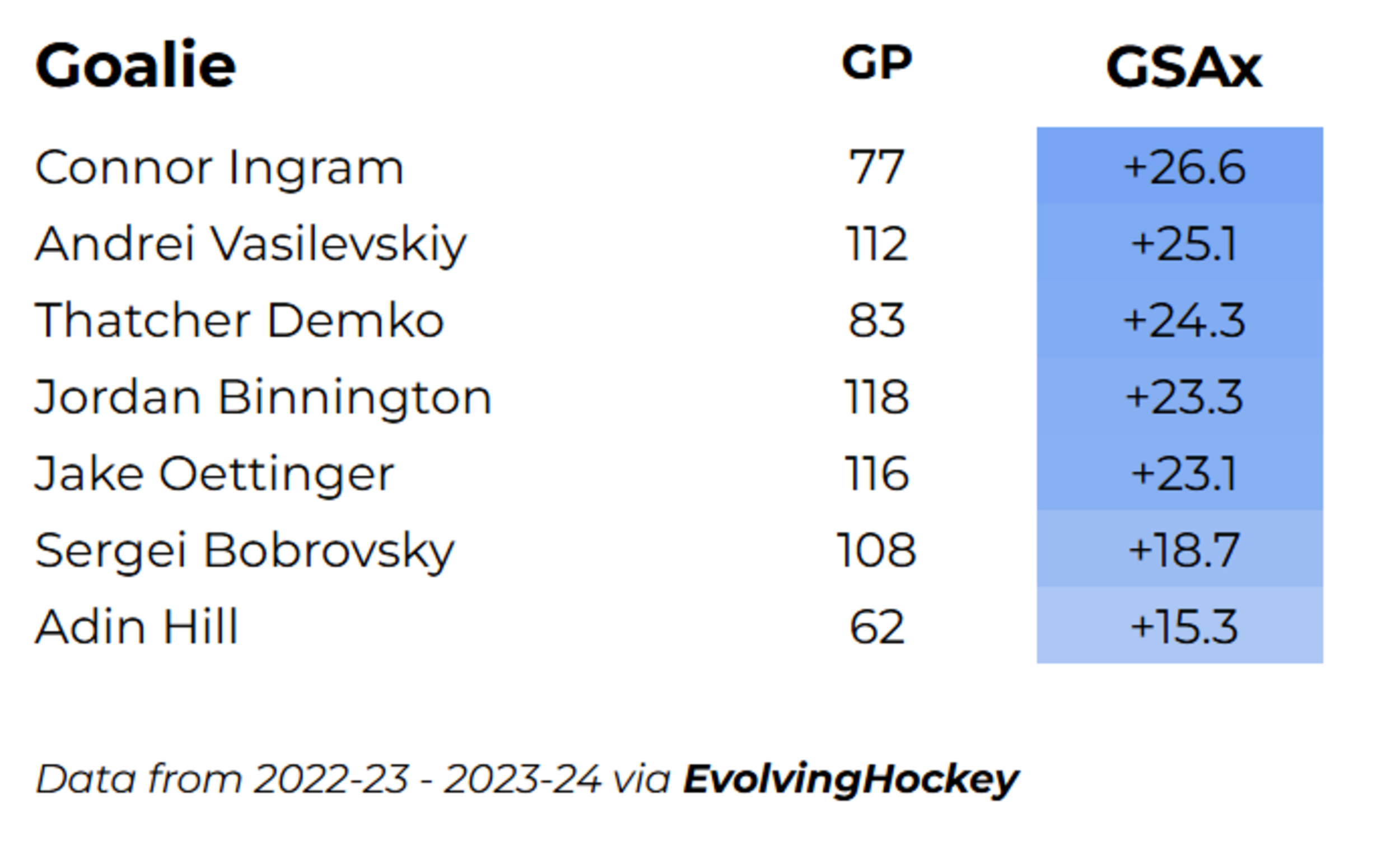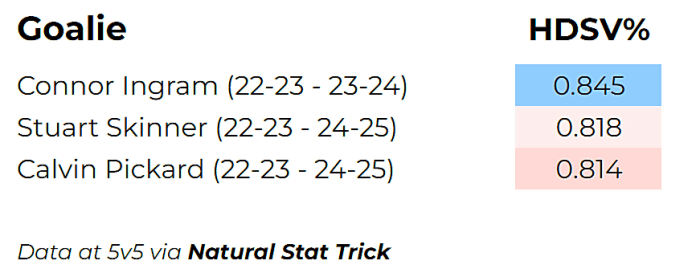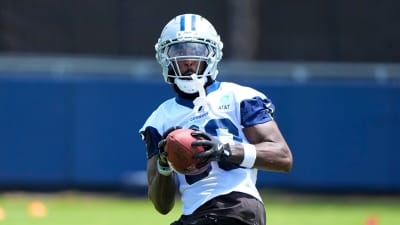
Behind Connor McDavid’s next contract, the Edmonton Oilers’ goaltending is poised to be their biggest question mark for 2025-26. They will begin the upcoming season with Stuart Skinner and Calvin Pickard in net, the goaltending tandem they have used over the past two years.
Given the inconsistency and variance of their performance, much ink has been spilled over whether Skinner and Pickard are truly sufficient for the Oilers to finally win the Stanley Cup. However, Edmonton recently made a move that I believe could significantly alter the outlook of their net-minding.
On October 1st, the Oilers traded for goaltender Connor Ingram from the Utah Mammoth in exchange for future considerations. 50 percent of Ingram’s cap-hit is retained in this deal.
At first glance, this move may seem like a nothingburger. After all, Ingram had a dreadful save percentage of 0.882 in 22 games for Utah last season, and just prior to being traded to Edmonton, he was placed on waivers and went unclaimed. He is projected to begin the 2025-26 season with the Bakersfield Condors, Edmonton’s AHL affiliate.
Nevertheless, I would strongly argue that Ingram has a lot more upside and potential than many think. In my mind, this is not just a depth move, but a move for a goalie that has a genuine chance to be a difference-maker in 2025-26. Let’s dive deeper into his career to see why.
Ingram was drafted 88th overall in the 3rd round of the 2016 NHL draft by the Tampa Bay Lightning, but his first two seasons in a full-time NHL role came with the Arizona Coyotes in 2022-23 and 2023-24. On the surface, his box score totals of a 0.907 SV% and a 3.08 GAA in those two seasons aren’t particularly impressive. Solid, for sure, but nothing to write home about, and certainly not an objective upgrade on Skinner or Pickard.
However, the problem with traditional stats like SV% and GAA is that they do not account for shot quality. SV% treats every shot – whether a weak wrister from the point or a 2-on-0 breakaway – as the same, and GAA fails to adjust for both shot volume and quality. This can cause goalies on teams with poor defending to rank much worse in these metrics compared to goalies behind much superior defence, even if their true abilities aren’t far off. This is especially the case for a goalie like Ingram who played for Arizona, a team that ranked 5th last in scoring chances allowed from 2022 through 2024.
That’s why I like to use stats such as GSAx (Goals Saved Above Expected) and HDSV% (High-Danger Shot Save Percentage). Unlike plain old SV%, GSAx weights every shot differently based on the quality of each shot, and HDSV% specifically includes dangerous shots in an attempt to level the playing field when comparing goalies. You can read more about the details of how GSAx is calculated right here. While these metrics are far from perfect and have some flaws of their own, they are considerably more reliable and fair than SV% and GAA at the very least.
And when using these more detailed metrics, Ingram ranks exceedingly well.

From 2022-23 through 2023-24, Connor Ingram had a +26.6 GSAx per EvolvingHockey. What this stat tells us is that, based on the volume and quality of the shots that Ingram faced, he saved about ~26-27 goals more than he was expected to. Or, to put it in another way, the Coyotes would have allowed about ~26-27 more goals if an average goalie was in place of Ingram.
Among all 114 goaltenders that faced a minimum of 50 shots in that span, Ingram ranked 10th in GSAx. That put him ahead of numerous notable names, such as Andrei Vasilevskiy, Thatcher Demko, and Sergei Bobrovsky just to name a few. Again, GSAx isn’t perfect, and should not be treated as the be-all-end-all, but this is certainly quite impressive.
Furthermore, per Natural Stat Trick, Ingram had a 5-on-5 save percentage of 0.845 on high-danger shots. Just to put that into perspective, Connor Hellebuyck – the 2023-24 Vezina winner – had a high-danger save percentage of 0.843 in that span. And yet again, this ranks higher than names like Vasilevskiy and Bobrovsky, and just behind Igor Shesterkin.
Notably, this ranks considerably higher than both Skinner and Pickard.
In the past three seasons, Skinner has a 0.818 save percentage on high-danger shots at 5-on-5. That places him 49th in the league. Skinner’s low-danger save percentage ranks at a very solid 13th in the NHL, but high-danger shots, specifically those off the rush and/or dangerous passes, are a significant weakness in his game, and this is clearly evident in the data. It’s a somewhat similar story with Pickard, who ranks 20th in low-danger save percentage but 55th in high-danger save percentage (0.814).

Fortunately, Ingram ranks quite well in this area where both of Edmonton’s main goalies struggle with, and Ingram has accomplished this behind a substantially worse defence. Not to mention, he also led all goalies in shutouts in 2023-24. All-in-all, his results from 2022-23 through 2023-24 are extremely encouraging.
But unfortunately, Ingram struggled mightily in 2024-25. This was evident in both the basic and advanced stats.
In 22 games with Utah in 2024-25, Ingram had a raw save percentage of just 0.882. His HDSV% dropped to 0.826, and in total, his GSAx was -6.9, meaning he allowed about 6-7 goals more than expected to. Not good at all, and it certainly poses a big question mark about his future performance.
That being said, it is important to acknowledge that Ingram faced several significant external challenges during the 2024-25 season.
Ingram sustained an upper-body injury in November 2024, sidelining him until mid-January. Then, on March 9, he entered the NHLPA’s Player Assistance Program following the passing of his mother.
This marked his second time in the program; Ingram had previously sought support in 2021 while battling obsessive-compulsive disorder, a period during which he nearly retired. His resilience and commitment to his career earned him the Bill Masterton Memorial Trophy in 2023-24. And so, while he did struggle in 2024-25, his off-ice challenges must be kept in mind.
Heading into 2025-26, Ingram is expected to begin the season with Bakersfield as he works to find his game before a potential NHL recall. As the underlying numbers from his previous two seasons point to a goaltender with real talent and upside, I believe Ingram could greatly benefit from a fresh start in Edmonton. This is a goalie could legitimately challenge both Stuart Skinner and Calvin Pickard for an NHL role given his performance as a legit starter in 2023-24, and it wouldn’t be shocking at all to see him starting playoff games next spring for the Oilers.
All things considered, the Connor Ingram trade is a no-risk move with a potentially very high reward. I eagerly look forward to seeing how he performs.
*All stats via EvolvingHockey and Natural Stat Trick
More must-reads:
- Could Penguins ask Sidney Crosby to waive no-movement clause amid rebuild?
- What Connor McDavid's discount extension means for Oilers
- The 'Active 10-reception NFL games' quiz
Breaking News
Trending News
Customize Your Newsletter
 +
+
Get the latest news and rumors, customized to your favorite sports and teams. Emailed daily. Always free!








